Spring supports multiple types annotations such as @Component, @Service, @Repository. All theses can be found under the org.springframework.stereotype package.
@Bean can be found under the org.springframework.context.annotation package.
When classes in our application are annotated with any of the above mentioned annotation then during project startup spring scan(using @ComponentScan) each class and inject the instance of the classes to the IOC container. Another thing the @ComponentScan would do is running the methods with @Bean on it and restore the return object to the Ioc Container as a bean.
@Component
If we mark a class with @Component or one of the other Stereotype annotations these classes will be auto-detected using classpath scanning. As long as these classes are in under our base package or Spring is aware of another package to scan, a new bean will be created for each of these classes.
package com.beanvscomponent.controller;
import org.springframework.stereotype.Controller;
@Controller
public class HomeController {
public String home(){
return "Hello, World!";
}
}
There's an implicit one-to-one mapping between the annotated class and the bean (i.e. one bean per class). Control of wiring is quite limited with this approach since it's purely declarative. It is also important to note that the stereotype annotations are class level annotations.
@Bean
@Bean is used to explicitly declare a single bean, rather than letting Spring do it automatically like we did with @Controller. It decouples the declaration of the bean from the class definition and lets you create and configure beans exactly how you choose. With @Bean you aren't placing this annotation at the class level. If you tried to do that you would get an invalid type error. The @Bean documentation defines it as:
Indicates that a method produces a bean to be managed by the Spring container.
Typically, @Bean methods are declared within @Configuration classes.We have a user class that we needed to instantiate and then create a bean using that instance. This is where I said earlier that we have a little more control over how the bean is defined.
package com.beanvscomponent;
public class User {
private String first;
private String last;
public User(String first, String last) {
this.first = first;
this.last = last;
}
}
As i mentioned earlier @Bean methods should be declared within @Configuration classes.
package com.beanvscomponent;
import org.springframework.context.annotation.Bean;
import org.springframework.context.annotation.Configuration;
@Configuration
public class ApplicationConfig {
@Bean
public User superUser() {
return new User("Partho","Bappy");
}
}
The name of the method is actually going to be the name of our bean. If we pull up the /beans endpoint in the actuator we can see the bean defined.
{
"beans": "superUser",
"aliases": [],
"scope": "singleton",
"type": "com.beanvscomponent.User",
"resource": "class path resource
[com/beanvscomponent/ApplicationConfig.class]",
"dependencies": []
}
@Component vs @Bean

I hope that cleared up some things on when to use @Component and when to use @Bean. It can be a little confusing but as you start to write more applications it will become pretty natural.

